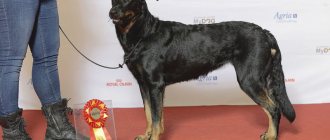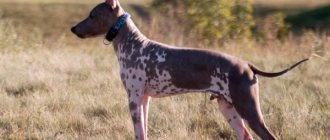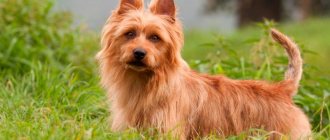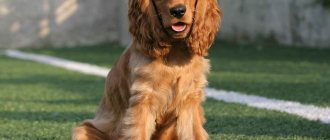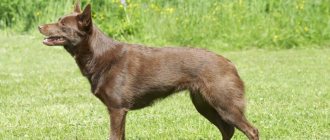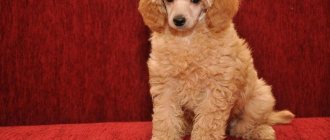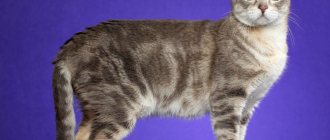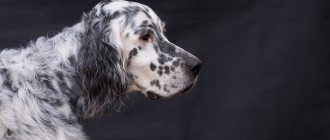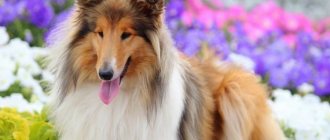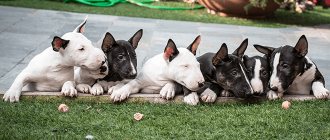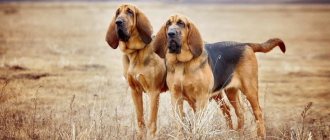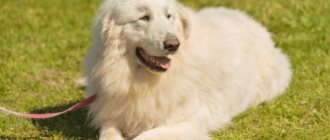The Australian Cattle Dog is a famous breed that stands out from the rest for its excellent herding qualities. That is why its name is Australian heeler, which is translated from a foreign language as “heel”. As numerous reviews from owners say, these pets are excellent at managing livestock, which is why representatives of this breed can often be found on farms. If an animal begins to stray from the pack (for example, a cow or sheep), the blue heeler begins to lightly bite their legs, which leads to the acceleration of the animal. This herding technique was first recorded in Australia back in 1903. It was there that this breed was first registered, which has become widespread today.
History of origin
The ancestor of the breed is considered to be the aboriginal dingo dog. The name comes from the English word “heel”, which translates as “heel”. The Australian heeler received it due to the habit of biting cattle on the legs while being driven into the stall. The animals were bred by the famous breeder Thomas Hall, whose goal was to obtain smart and hardy dogs for guarding and driving cattle. Dingoes and collies took part in the experiment. At first, heelers lived only on the breeder’s farm, but after his death it was sold, and others learned about the breed.
Interested breeders and farmers were engaged in further improvement of the Australian Cattle Dog. Officially, the first heelers were registered in 1903 (crossing involved Cattle Dogs, Dalmatians, and Australian Kelpies). Closer to the 40s, the breed became known in other countries, and they began to be exported to the USA and Canada. After this, Europeans also became interested in healers, and the dogs became popular in Great Britain. In Russia, the Australian Cattle Dog appeared only in 2004. Today this variety is considered one of the rarest; about 200 purebred individuals are registered in the country.
Kinds
The closest relatives of Australian heelers are stumpies, or bob-tailed heelers. In Australian history, their ancestors were artificially bred to drive cattle for the markets of Sydney. Other dogs could not cope with guarding cows and sheep in hot climates and rough terrain.
Crossing the English hardy Smithfield and wild dingo dogs, adapted to the local climate, gave the desired result. The aggressiveness of the mestizos was softened by mixing with the marbled smooth collie. Until 1927 it was one breed, which later developed into two directions:
- Australian short-tailed cattle dogs (heelers);
- Australian Cattle Heelers.
The word “heeler” unites the breeds and conveys the characteristic feature of dogs guarding herds. Translated from English, heeler means “heeler.” This is the name given to dogs that can bite the limbs of artiodactyl animals in order to direct their movement in the desired direction.
This is exactly what the Australian shepherd copes with masterfully . The healer deftly falls to the ground after a bite so as not to be hit by a hoof. This specific method of control without the usual barking distinguishes herding dogs from other breeds of four-legged animals.
It is important to know!
If you decide to get an Australian Heeler that you intend to keep in your yard, then be prepared for regular escapes. These dogs are incredibly inquisitive, they will instantly explore the entire territory and will definitely find a loophole through which they can escape from a confined space. They often dig under a fence or gate. Such behavior can seriously puzzle any person, but, as a rule, healers always return home, as they are very attached to their owner.
a brief description of
The Australian Heeler is a herding dog breed that is distinguished by its tirelessness, great endurance and high performance. This is a fearless protector, a loyal friend and a reliable life partner. If you decide to get such a pet, then be prepared for devotion and great love from your four-legged friend; you simply cannot find a better companion.
Heelers love children very much, they play with them with pleasure and protect them from trouble. These dogs are incredibly loyal to their owner; they quickly become attached to one person and feel sad if that person leaves for a long time. For Australians, loneliness is a real punishment, so if you are a busy person and constantly travel for work, it is better to choose a more stress-resistant pet.
Australian shepherds can easily be called the standard of devotion and fidelity. They will never leave their family in trouble, they will always be there and become a reliable shield in case of danger. Animals are endowed with a high level of intelligence, they clearly understand what is wanted from them, and are well trained and educated. However, due to their innate herding instinct, they often die under the wheels of cars, so it is best to keep such pets in rural areas. In addition, they need space, fresh air and the opportunity to do what they love.
Heelers are very mobile, active, love to play in nature, they are ideally suited for country life. Among other things, this is a very hardy and hard-working dog. If you have a farm in the form of a small herd, then she will be happy to take patronage over it.
Breed standard
Dogs of this variety are compact in size, but at the same time their body is very well developed, due to which they are strong and resilient. Heelers have a harmonious physique; the dogs have common features with collies and Australian shepherds.
The average height of males is 47-50 cm at the withers, females are 3-4 cm lower. Body weight rarely exceeds 20 kg. The tail is short and low set, and is actively used when running. Athleticism indicates the mobility of dogs that are always ready for any challenge.
If we talk about behavior and character, the Australian Heeler is an endlessly devoted and faithful dog. The animal will follow its owner everywhere and try to please him. The advantage of the variety lies in its pronounced protective qualities; the dogs protect not only livestock, but also the farmer’s property. Healers are distrustful of strangers and show aggression towards strangers. With this feature, the dog must be obedient and obey its owner unquestioningly.
Expert opinion
Anna Abramenko
An avid dog lover. Experience in veterinary medicine since 2009.
Ask a Question
Representatives of the breed have high intelligence; the dog is always vigilant and careful. Heelers are easy to train, quickly remember commands and execute them. In direct functions, these cattle dogs have no competitors, since they control and drive sheep and cows better than others. At the same time, healers cope with the task both in open areas and in confined spaces. Any deviation in behavior is regarded as a serious defect and is grounds for disqualification.
IFF standard:
- Purpose. The dog is used to herd and guard cattle.
- Appearance. Proportional, compact, harmonious.
- Head. Strong, consistent with body size and general build. The skull is quite wide, slightly convex.
- Facial area. The heeler has a powerful muzzle that gradually tapers towards the nose. The cheekbones are quite soft and smoothed. The jaw is strong and well developed. The nose is completely black.
- Ears. Medium size, slightly pointed. They should be widely spaced and turned to the sides. The inside is covered with wool.
- Bite. It has a scissor-shaped shape. The teeth are of medium length, well set. When closing, the jaws are in close contact with each other.
- Eyes. Small, oval shaped. They are located relatively shallowly, the color is dark brown.
- Neck. Medium length, strong and robust.
- Frame. The heeler has a powerful, wide back with straight lines. The chest is muscular and moderately large.
- Croup Quite long and sloping.
- Tail. Set low. Should be lowered when at rest. According to the standard, it is not subject to docking.
- Forelegs. The heeler's paws are set wide, located at a good angle to the withers. The joints are strong and developed. The fingers are quite short, with dark, hard pads and sharp claws.
- Hind limbs. Strong and muscular. The knee joint should form a pronounced angle.
- Stomach. Fit and straight.
According to the breed description, the Australian Heeler has a thick and smooth coat with a pronounced undercoat. It does not get wet and fits tightly to the body, so dogs are not afraid of rain and cold. The hairs are quite short, as a rule, the length varies between 2.5–4 cm. In the area of the muzzle, neck and front of the limbs, the hair is slightly shorter.
As for color, the heeler has two types of colors:
- Blue speckled. The main shade is deep gray with a characteristic blue-silver undertone. Interspersed with white and black colors are allowed. Yellow-red markings may be present on the face. Similar markings are often present on the chest, front legs and throat.
- Red-speckled. The color must be even along the entire length of the body, white and gray spots are allowed. Uniform markings of a rich red color may be present on the face, neck and paws.
The dog's movements are free, flexible and smooth. When running, the heeler moves harmoniously and gracefully. A distinctive feature is the ability to make sudden and sharp movements.
Even a minor violation has a negative impact on health and impairs the ability to perform the main purpose. Therefore, the slightest deviation from the norm is regarded as the dog’s unsuitability for service.
The most common defects of healers are:
- weak or straight shoulder blades;
- thin cartilage fibers and ligaments in the joint area;
- straightened knee on the hind legs;
- unnatural movements.
Unreasonable aggression or fearfulness of the animal is also a reason for disqualification.
Interesting! The Australian Cattle Dog's body length should be greater than the height at the withers. The optimal ratio is 10:9.
History of the Lancashire Heeler breed
The homeland of Lancashire Heelers is clearly stated in the breed standard - Great Britain.
Archaeological research carried out in the British Isles has made it possible to find multiple images of dogs similar in build and color to Lancashire dogs.
Examples of dogs similar in appearance to modern Lancashires were more often found in Lancashire, where these dogs got their nickname.
There is reason to believe that the blood of Welsh Heelers, Cardigan Welsh Corgis, Pembroke Welsh Corgis, Spitz and Manchester Terriers is mixed in the veins of Lancashires.
Targeted selection work with this breed of dogs was not carried out until the mid-1960s, when several enthusiasts, due to the threat of extinction, came up with the idea of restoring the Lancashire Heeler breed.
During the selection process, Manchester Terriers were crossed with Welsh Corgi Cardigans to produce puppies of a new breed that inherited many positive qualities (including herding) of their ancestors.
Photo 1. Lancashire heelers have a dense, well-built, muscular build
The resulting offspring were again crossed with each other, the “defective” specimens were sifted out, thanks to which it was possible to create a breed that is now commonly called the Lancashire Heeler.
In 1978, the first kennel club was created, uniting lovers of Lancashire heelers, and three years later the first breed standard was developed.
The English Kennel Club recognized the new breed in 1981, and the International Canine Federation recognized it another 35 years later (in May 2016).
The official participation of Lancashire heelers in authoritative exhibitions was recorded in 1984.
In 1988, a stud book of Lancashire Heelers was created, which included data on seven and a half hundred purebred representatives of this breed.
The baton of mass breeding of Lancashire heelers was actively picked up by breeders from Scandinavia, Belgium, Holland, and the USA.
In 1989, the Swedish Lancashire Heelers Club was registered, in 2003, a similar club was registered in Finland, and in 2010, Norway.
It is in these countries that the largest number of purebred Lancashires outside the UK is concentrated.
Lancashire Heelers are capable of producing from 2 to 4 puppies per year, which is why it is not possible to quickly increase the number of dogs of this breed.
Around the world, about three hundred Lancashire Heeler puppies are born each year. In total, there are just over 4 thousand individuals of Lancashire.
There are practically no purebred Lancashires in Russia, since Russian nurseries are not yet involved in breeding them.
Rare representatives of this breed are registered in Moscow and the Moscow region; they are counted in just a few.
Australian Heeler Health
The Australian Heeler is a strong, resilient dog, accustomed to life in difficult conditions. However, like any other breed, it has a genetic predisposition to certain diseases, which are listed below.
Having puppies undergo a medical examination in the first months of life helps prevent the spread of diseases in the family.
By the way! Not all carriers of genetic defects exhibit certain defects. Sometimes the gene is found only in offspring or even after several generations. Therefore, all breeders recommend studying the pet’s pedigree before purchasing. The puppy must also undergo a series of medical examinations to avoid further spread of genetic defects.
Most common diseases
The weaknesses of Australian heelers can be divided into three groups according to the most vulnerable part of the body:
- ears
The most common ailment among Australian heelers is congenital deafness, which affects some blue-colored animals. There are also less radical options - partial deafness. According to statistics, every fourteenth healer hears in only one ear.
Early diagnosis of possible hearing problems is being actively implemented in many countries besides Australia
Within Australia, all heelers undergo a hearing aid examination at the age of one and a half months. This examination allows us to limit the number of dogs with deafness. Gradually other countries are coming to this method;
- bite
Another genetic “flaw” of the Australian Heeler is the bite. Many representatives of the breed, despite well-developed jaws, experience a lack of teeth. Normally, an individual should have a set of 42 teeth, which is not so common.
Loss of teeth may make it impossible for a heeler to perform his duties as a herding dog.
If the dog is missing more than 3 pieces, the deviation is marked as defective. When buying puppies, it is advisable to get to know the jaws of the parents, since lack of teeth is inherited and progresses from generation to generation;
- joints
The real Achilles heel of the Australian Heeler is the joints. In Australia, breeders manage to promptly eliminate individuals with joint dysplasia from breeding, while in Europe this defect is not monitored so strictly, and therefore is actively transmitted to offspring.
Joint problems are found in almost half of the individuals due to the carelessness of breeders
The situation continues to worsen - in Finland, almost half of registered healers are affected by this disease. Dysplasia usually affects overweight dogs, but with a hereditary predisposition it can also spread to fit, medium-sized dogs;
By the way! There is a common misconception among many breeders and hobbyists that mating blue heelers with red heels produces the healthiest offspring. The health of an individual is determined solely by a set of genes, in which color is not directly involved.
- eyes
A predisposition to progressive blindness is also common among Australian healers. The reason for this fairly common defect is that, as a result of numerous mating options, the gene responsible for the atrophying retina has been fixed in this breed.
Unfortunately, loss of vision, especially in old age, is a common occurrence among healers
Typically, the first signs of blindness appear in an individual between 1 and 5 years of age. The symptoms appear rather mildly at first - the Australian Heeler begins to navigate worse in the dark and twilight. There is slight clumsiness, which was previously unusual for the dog.
A comprehensive puppy check will help you avoid encountering an incurable disease in the future.
The gradually atrophying retina of the eye can become a problem for many owners. If desired, you can conduct a genetic test that will determine the susceptibility of a particular individual to the disease. Dislocation of the lens of the eye, cataracts and other eye diseases are much less common.
Life expectancy of an Australian Heeler
On average, Australian dogs live up to 15 years. There are also excellent long-livers, reaching the age of twenty.
The longevity of a pet largely depends on the attentive attitude towards it from the owner.
Description, appearance of the Australian Shepherd
The height of an adult Australian Shepherd does not exceed 56-58 cm. This breed received the status of a herding dog for its ability to very easily cope with herding a large herd or flock. Coat coloring can vary, but the most common variations are marbled red or marbled blue.
Breed standards
According to the FCI classification, the Australian Shepherd has very correct proportions, a slightly elongated body, medium size and the following standards:
- the head is clearly defined, strong and dry, proportional to the body, with a small occipital protuberance and a moderate or well-defined stop. The pigmentation of the nose and lips varies depending on the color of the coat and can be black or light brown. The presence of pink spots is allowed, the number of which should not exceed a quarter of the total surface;
- the muzzle is cone-shaped, with a characteristic rounding at the end. The teeth should have a scissor or level bite. The eyes are almond-shaped, with different types of eyelid pigmentation. The ears are triangular, medium in size, set high on the head;
- The neck is strong and of medium length, slightly arched at the nape and set evenly on the shoulders. The back is straight and strong enough, strong and even all the way from the withers to the hip joints. The croup area is moderately sloping. The chest is not too wide, deep, with elastic and long, not barrel-shaped ribs. The abdomen is moderately tucked. A straight tail can be naturally long or naturally short;
- the forelimbs have straight and strong paws and are distinguished by strong, oval rather than round bones. Oval feet are compact, distinguished by collected and fairly curved toes with thick and elastic pads. The hind limbs have well-defined and moderately arched stifles, and the feet are oval and compact with thick, elastic pads.
The coat is not too long, has average density, can be straight or wavy, with sufficient resistance to any adverse weather factors. The hair on the head and front of the limbs is short and soft. There is a small mane and a characteristic frill, which are most pronounced in males.
Australian Shepherd personality
The movements of the Australian Shepherd are smooth, free and easy. An adult dog can demonstrate agility in its movements and a well-balanced run that trails along the ground. The movement of the front and hind legs is straight and parallel to the center line of the body. The Australian Shepherd is an agile breed and can quickly change direction and manner of movement.
The Australian Shepherd is a very loyal breed and will become a loyal friend to both adults and children. Among other things, this dog is an ideal and attentive student, grasping all knowledge very quickly. The breed loves active games and frequent walks, and expects attention and frequent approval from the owner. This is a very reliable, but completely unobtrusive and hardworking companion.
Training
Since the healer has a heightened sense of protection, such dogs will be indispensable as a guard. By nature they are non-aggressive, but they are distrustful and wary of strangers. The dog experiences endless love for its owner and good nature for other family members and relatives. Heelers do not get along with other pets.
Expert opinion
Anna Abramenko
An avid dog lover. Experience in veterinary medicine since 2009.
Ask a Question
Breeders are advised to train the Australian Cattle Dog from childhood. The dog must understand that the owner is the leader. If you give an animal freedom, predicting its future behavior will be problematic. In the absence of education, healers often show not only disobedience, but can even periodically bite people on the legs.
Since the dog is highly intelligent, it is easy to train and quickly remembers commands. At the same time, he learns with enthusiasm. Heelers are used not only as farmer's assistants, but also as guards and rescuers. If there is no experience in training, the owner is recommended to send the dog to a professional dog training center, where it will quickly be taught basic commands. During training, it is strictly forbidden to use force or raise your voice at the puppy.
On a note! Heelers are not recommended for families with children, since the dog will mistake the baby for an animal from the herd and try to coordinate its movements.
Brief characteristics of the breed representatives
The character of Australian Shepherd dogs is calm and friendly. Their content most often does not cause any particular difficulties. These pets are not fussy about feeding. They get along well with other animals and children.
Who are they suitable for?
Cynologists recommend getting an Australian dog for those who want a cheerful, energetic and active pet with whom they can spend their free time until sunset
The main thing is to be able to relax with your pet and give it your attention.
Who is better to choose: a male or a female?
If the male is castrated and the female is sterilized, there is practically no difference between them. This is due to the fact that such pets have approximately the same hormone levels.
If you choose an unsterilized female dog, you need to be prepared for the fact that she will go into heat every six months for 3 weeks. If you do not want puppies, the dog should be isolated during this period.
Can I keep it in an apartment?
Aussies require large areas to play and roam. That is why dog experts recommend that owners of country houses have such pets. However, you can also keep a dog in your apartment. You should be prepared for daily walks.
What is better to feed an Australian Shepherd: dry food or natural food?
The Australian Shepherd can be fed both dry food and natural food. Preference for one method or another should be given directly by the pet owner himself.
Dry food is distinguished by the absence of the need for pre-treatment, long shelf life and a balanced content of nutrients. Its main disadvantage is its significant cost.
As natural food, you can use meat, fish, dairy products, buckwheat, rice, oatmeal, vegetables, fruits and eggs.
Is it easy to train?
The Australian Shepherd Ossie is one of the breeds that is easy to train. She learns new commands very quickly and carries them out with pleasure if she approaches this activity correctly. For the training to be noticeably effective, it must be done regularly. The dog should exercise for as long a period of time as possible. At the same time, it is worth limiting agility exercises, and selecting complexes based on ingenuity.
How are Australian Shepherds used?
Currently, Australian Shepherds are used primarily in the United States. They help guard the herds of animals on the ranch. This breed is considered to be a good companion. Sometimes Australian dogs are used as utility dogs. They can help people with limited mobility navigate in space.
Mating
Breeding any pet requires time and effort from the owner. The dog must pass the necessary tests and confirm its status. Without documents she will not be allowed to breed.
Important! The mating must be registered with the club, otherwise documents for the litter will not be issued.
The bitch must be examined by a veterinarian, after which genetic tests are done. Individuals with plembrace are not allowed to breed. You can start breeding only after the dog is 2 years old.
For mating, it is better to seek the services of a specialist. The average duration of pregnancy is 2 months. There can be up to seven puppies in a litter. Repeated pregnancy is allowed only after two years.
Characteristics of the Australian Cattle Dog
| Attachment level | High |
| Friendliness | High |
| Child friendly | Average |
| Loyalty to other pets | Average |
| Exercise needs | High |
| Playfulness | High |
| Energy level | High |
| Learning ability | High |
| Intelligence | High |
| Tendency to bark | Average |
| Shedding amount | Average |
| Security | High |
Content
By character and temperament, dogs are more suitable for active people. Genetic predisposition requires constant walks and games, otherwise the energy will spill out at home. The best option for such a dog is to live on a farm or in a private cottage; it is not worth keeping them in apartments. This is due not only to the fact that the dog will be bored and uncomfortable, but also to the increased vocalism of dogs. The heeler always announces the arrival of guests or strangers with a ringing bark and will bark at neighbors passing in the entrance.
Keeping a healer will not cause any difficulties. Dogs are characterized by good health and a good immune system, so you won’t need to take them to the veterinarian often. The only thing that is recommended is to take your dog for a preventive examination every 6-10 months. The heeler's coat is prone to self-cleaning; caring for it will not cause difficulties even during shedding. You also don’t have to brush your dog every day; it’s enough to do the procedure every 8-10 days. Washing should be done as needed, but not too often. Once every 2 weeks, healers need to clean their ears. Nails are trimmed once a month.
Grooming
The breed is easy to look after. It is enough to brush your pet regularly and wash it if necessary. During normal periods, you need to comb the animal 2-3 times a week; during shedding, this is done daily, otherwise the fur will roll into tangles and it will be impossible to remove them.
To comb out, you need a fine-toothed comb or a slicker brush; it is best to use a furminator. It is also necessary to monitor the length of the claws. Sometimes they do not grind off naturally, in which case they are trimmed with special nippers. This is done by the owner himself or you can contact a groomer.
For your information! Sometimes puppies have their ears glued to make them stand upright. This is done only by a specialist who understands how to fix the hearing organs.
You only need to bathe your pet when it gets dirty. For this purpose, special shampoos for dogs are used, as they have a gentle composition. To highlight the Aussie's red tricolor color, you can use conditioner.
Once a week, the pet’s mouth is cleaned with a special paste, this stops the development of tartar.
Nutrition
Since the Australian Cattle Dog is a descendant of wild dingoes, the diet of such dogs should consist of raw meat, offal and fish. The only thing that needs to be pre-treated thermally is the liver. To ensure adequate nutrition, healers are also recommended to periodically give:
- natural fermented milk products;
- vegetables - beets, carrots, zucchini;
- eggs;
- buckwheat, rice and oatmeal with the addition of minced meat;
- fish fat;
- greenery.
If desired, Heeler dogs can also be given industrial food, but in this case it is recommended to use super-premium or holistic-class products. Budget food is intended solely to satisfy the feeling of hunger, but contains virtually no vitamins and microelements, and therefore has no health benefits.
Heelers tend to chew on everything; the owner needs to monitor their diet. Such dogs should not overeat, because, despite their activity, they are prone to gaining excess weight. In the absence of adequate physical activity, there is a risk of developing digestive problems. The list of prohibited products includes:
- bakery products;
- chocolate and other sweets;
- fruits;
- pork;
- potato;
- mushrooms;
- garlic and onion.
Expert opinion
Anna Abramenko
An avid dog lover. Experience in veterinary medicine since 2009.
Ask a Question
To keep the dog healthy, he is given only fresh and high-quality food.
Nutrition for puppy and adult dog
According to the recommendations of dog breeders, it is better to feed the Australian Heeler with natural food. But there are several important points in this dog’s diet.
The presence of potatoes, bread, especially yeast and white bread, onions and garlic, spices, sugar and mushrooms in the diet is strictly prohibited. It is also necessary to completely exclude fatty pork, smoked meats, various sausages, sausages, chocolate, citrus fruits and dried fruits.
From cereals you can give oatmeal, rice and buckwheat, which should be only 40%. The remaining volume is filled with raw, lean meat (chicken, beef, turkey) or offal except liver. It needs to be boiled. A couple of times a week you can give your dog sea fish and boiled eggs. You can give your dog cooked vegetables, except those excluded.
Fermented milk products can be given daily to both a puppy and an adult dog. The exception is females in heat. These products often aggravate false pregnancy. Sometimes you can give apples and seasonal berries instead of treats. And don’t forget about natural mineral supplements such as kelp, seaweed, fish oil, spirulina, herbs and flaxseed oil.
Deworming
Regardless of the conditions in which the animal is kept. The risk of parasite infection is always quite high. Therefore, dogs and puppies need to be dewormed once a quarter for preventive purposes. In this way you can protect yourself and other pets from possible infection. This is of particular importance before mating, since infection with parasites can occur in puppies in utero through the bloodstream and when feeding on mother's milk.
Puppies can be wormed starting at 3 weeks of age. For them, parasitic infections are very dangerous; they can lead to developmental delays and even death. Oddly enough, most often pets become infected from their owners.
How to choose a puppy
Before buying a dog, you need to familiarize yourself not only with its external description, but also with its character and temperament. If you purchase a heeler solely based on the species, you may regret the decision in the future, since it requires a lot of time to be devoted to it.
When choosing a puppy, it is recommended to follow these tips:
- Preliminarily study information and reviews about a particular nursery;
- ask the breeder to provide the necessary documents.
Dog handlers do not recommend adopting a dog from a female's first litter, since they are more likely to develop defects than others.
Choosing a puppy
If you nevertheless decide to buy yourself an Australian Shepherd puppy, then be sure that this task will not be the easiest for you. Often, a free search on the Internet will not give you any results, even if you are hoping to buy a puppy without eminent parents and a serious pedigree. Today, few people engage in free commercial breeding of this breed. The only option is to find the owners of this type of dog at major exhibitions; only in this case is it possible to acquire an Australian Cattle Dog puppy. The price of such an animal is relatively low and ranges from $300-500 US per individual.
Did you know? Puppies are born toothless and develop their first teeth approximately 4 weeks after birth.
But, even if you managed to find a heeler puppy, rest assured that your trials are not over. You should choose the best individual from the litter, so that in the future your pet will only please you and bring only positive emotions. Therefore, before buying a dog, we advise you to familiarize yourself with the official breed standards; this will protect you from buying a non-purebred dog or an individual with defects.
A healthy dog must meet the following criteria:
- good nutrition, no bloating;
- well-fitting, shiny coat;
- clean mucous membrane of the eyes, without any signs of conjunctivitis;
- cold and wet nose, without excess discharge;
- the front and hind legs should be without seals on the joints and parallel to each other;
- in males the testes should be palpable;
- At the age of 2 months, the puppy should eat solid food.
Colors
There are several types:
- Red.
Uniform red speckling throughout the body and undercoat (not cream or white). There may be red spots of a darker color on the head. The presence of uniform markings on the head is desirable. Red markings on the body are acceptable, but are considered a fault. - Blue.
May be with or without spots. Specks in the head area of black, blue, and fawn colors are allowed. The presence of a fawn undercoat is acceptable if it does not protrude from the top coat. The disadvantage is the presence of black marks on the body.
Average prices
Since this dog breed is quite rare and has not yet spread to Russia, the cost of purebred puppies is high and starts at 40,000 rubles. The price varies depending on the nursery, parents and gender. In any case, you need to purchase a heeler from trusted breeders with a good reputation.
The Australian Cattle Dog will become a devoted friend and companion. These dogs are active, inquisitive, playful and loyal. But before you buy such a dog, you need to carefully weigh everything, since you cannot leave them alone. In general, this breed is ideal for people living in private homes.
Pros and cons of the breed
The advantages can be safely called good nature, love for children, affection and devotion. In addition, dogs have excellent intelligence and are easy to train. The disadvantage may be disobedience under certain conditions (improper upbringing, monotonous commands, keeping in an apartment).
Price of puppies
The price in Russia averages 40,000 rubles. The cost of an individual puppy may vary depending on gender, age, pedigree and vaccinations. It is best to buy such a dog in the summer, then the price for them drops significantly.
How to choose a puppy
The main factors when choosing an Australian Cattle puppy include the following: the presence of the necessary documents, the presence of a certain authority with the breeder, the puppy should not be from the first litter of the bitch. The puppy should have a healthy and strong appearance.
Nickname selection
For such active dogs of boys, the following nicknames are suitable: Addie, Aktai, Zhai, Kabai, Nabbi, Chaidi, Yumi. For girls: Bullet, Nami, Nika, Bertha, Amanda, Montana.
Character and temperament
It is immediately worth noting that excessive aggressiveness or cowardice is considered a disqualifying vice. True Australian heelers must have a natural sense of loyalty and devotion, harmoniously combined with protective instincts. Such qualities provide the owner with an excellent working dog for guarding the herd and farmland, as well as a good friend.
The purpose of the breed has brought up a certain type of dog character: they are distrustful of strangers and animals, but obedient enough for training. The natural psychology of the Kettle Dog ensures impeccable driving and protection of livestock. This is an ideal working dog.
In modern conditions, the need for dogs on farms has dropped sharply and Australian cattle dogs are used much less frequently for their intended purpose. Owners note the qualities of a companion dog in healers. They are suitable for young people with an active position and enough free time.
Healer diseases and life expectancy
As a rule, Kettle Dogs have excellent health, possibly due to the blood of wild dingoes. Some hereditary diseases may be present.
So, healers are predisposed to:
- deafness;
- dysplasia of the hip or elbow joints;
- progressive blindness.
In general, with proper nutrition and lifestyle, Australian Heelers belong to the category of long-lived breeds. On average, they live 14-16 years, but one of the representatives of the Australian shepherds lived for almost 30 years. This fact is included in the Guinness Book of Records.
Heelers are still used today by Australian farmers to accompany herds of cows, sheep, goats, horses and even ducks. These dogs perform well in agility or obedience sporting events. Often used as guards and companion dogs. When deciding to get a heeler, you should remember that city life is not suitable for him. And, of course, soberly assess your ability to cope with such a difficult dog. If this succeeds, he will be a faithful and reliable friend, devoted to his family with all his heart.
